
Substitute Teacher Cover Letter Examples & Templates (2025)
Tired of constantly looking for subbing jobs? With this substitute teacher cover letter, you will be on every principal’s speed dial.

Dave Rygielski
Career Expert
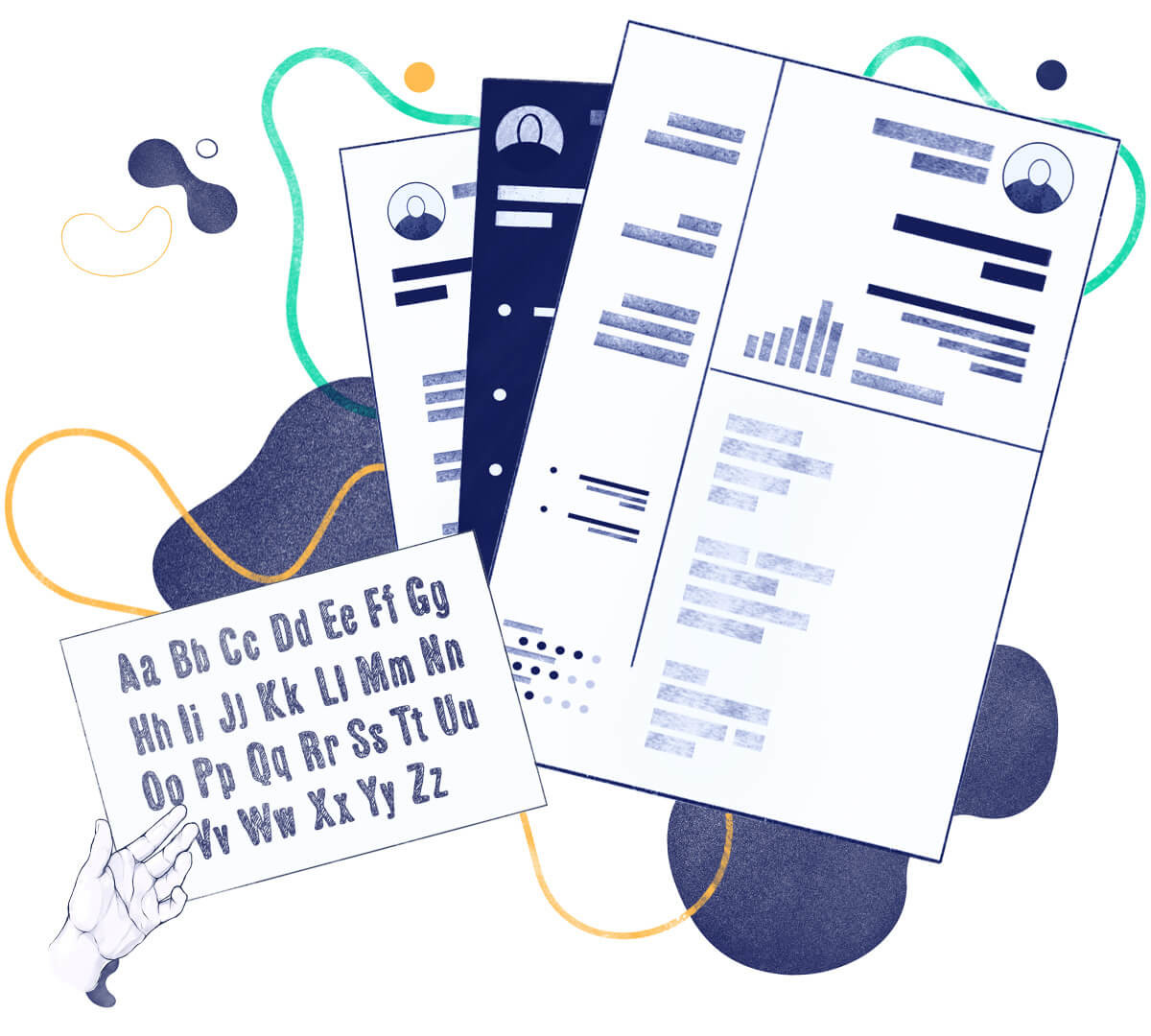
After completing a resume, creating another document for your job application seems as exciting as extra homework. But a teacher cover letter might be the only thing separating you from a cozy job at an elite school. I’ll show you how to write a cover letter for teaching jobs that will tip the scales in your favor.
Top Insights:
Save hours of work and get a cover letter like this. Pick a template, fill it in. Quick and easy. Choose from 20+ cover letter templates and download your cover letter now.
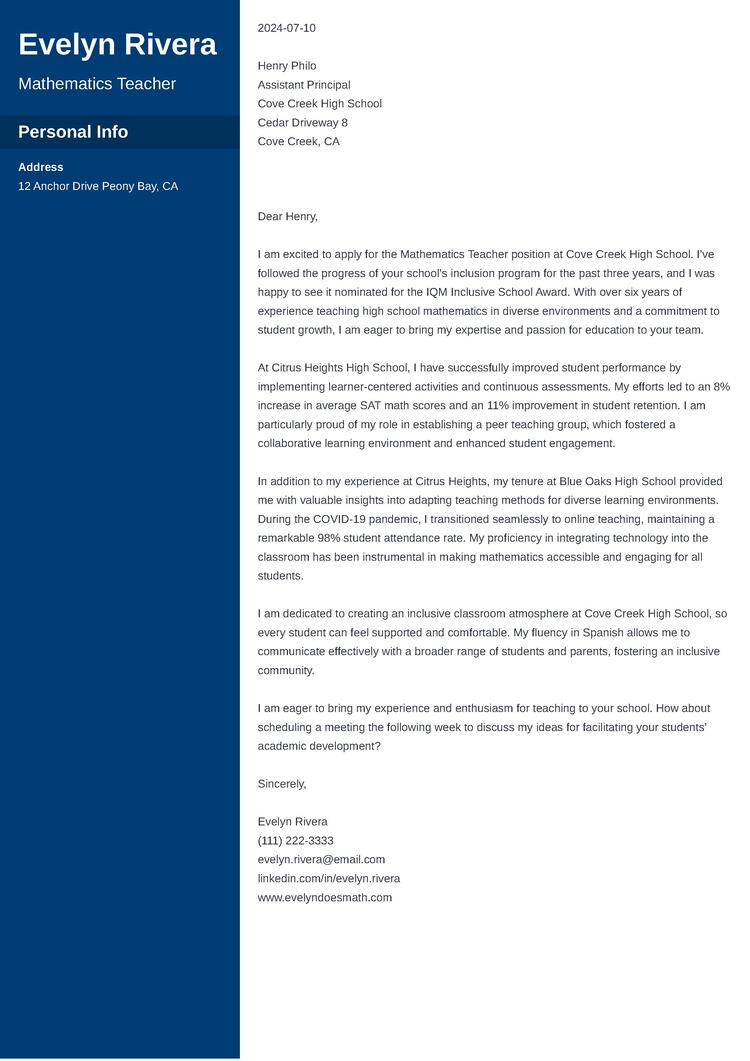
What users say about ResumeLab:
I had an interview yesterday and the first thing they said on the phone was: “Wow! I love your cover letter.”
Patrick
I love the variety of templates. Good job guys, keep up the good work!
Dylan
My previous cover letter was really weak and I used to spend hours adjusting it in Word. Now, I can introduce any changes within minutes. Absolutely wonderful!
George
Evelyn Rivera
Mathematics Teacher
12 Anchor Drive
Peony Bay, CA
July 10, 2024
Henry Philo
Assistant Principal
Cove Creek High School
Cedar Driveway 8
Cove Creek, CA
Dear Henry,
I am excited to apply for the Mathematics Teacher position at Cove Creek High School. I’ve followed the progress of your school’s inclusion program for the past three years, and I was happy to see it nominated for the IQM Inclusive School Award. With over six years of experience teaching high school mathematics in diverse environments and a commitment to student growth, I am eager to bring my expertise and passion for education to your team.
At Citrus Heights High School, I have successfully improved student performance by implementing learner-centered activities and continuous assessments. My efforts led to an 8% increase in average SAT math scores and an 11% improvement in student retention. I am particularly proud of my role in establishing a peer teaching group, which fostered a collaborative learning environment and enhanced student engagement.
In addition to my experience at Citrus Heights, my tenure at Blue Oaks High School provided me with valuable insights into adapting teaching methods for diverse learning environments. During the COVID-19 pandemic, I transitioned seamlessly to online teaching, maintaining a remarkable 98% student attendance rate. My proficiency in integrating technology into the classroom has been instrumental in making mathematics accessible and engaging for all students.
I am dedicated to creating an inclusive classroom atmosphere at Cove Creek High School, so every student can feel supported and comfortable. My fluency in Spanish allows me to communicate effectively with a broader range of students and parents, fostering an inclusive community.
I am eager to bring my experience and enthusiasm for teaching to your school.
How about scheduling a meeting the following week to discuss my ideas for facilitating your students’ academic development?
Sincerely,
Evelyn Rivera
(111) 222-3333
evelyn.rivera@email.com
linkedin.com/in/evelyn.rivera
www.evelyndoesmath.com
What makes it work:
Subject Line: Biology Teacher Joshua Madison seeks teaching position at Williamsburg Middle School
Dear Mr. Pandolf,
I am pleased to apply for the Biology Teacher position at Williamsburg Middle School. With a Master of Science in Teaching from Fordham University and hands-on experience as a student teacher, I am passionate about fostering a love for biology in students.
While learning from experienced educators and student teaching at Jamaica Bay High School, I’ve developed an engaging biology curriculum and lessons for grades 7–12 that used the blended learning approach. I received 100% positive feedback from all students I’ve worked with as well as a commendation from the school principal for smooth classroom management.
I am eager to bring my skills in curriculum development, student engagement, and technology integration to Williamsburg Middle School. How about scheduling a call to discuss how I can contribute to students’ success?
Best regards,
Joshua Madison
Biology Teacher
(222) 333–4444
joshua.madison@email.com
linkedin.com/in/joshua.madison
What makes it work:
Parker Jensen
History Teacher
(333) 444–5555
parker.jensen@mail.com
linkedin.com/in/parker.jensen
June 11, 2024
Hiring Committee
Marginal Way Middle School
4 Briar Bank Rd.
Ogunquit, ME
Dear Hiring Committee,
I am excited to apply for the History Teacher position at your esteemed institution. With a Master of Arts in Teaching and a diverse range of teaching experiences, including my current role at Spruce Head Middle School, I am passionate about inspiring students through engaging history education.
In your job advertisement, you mentioned that you’re seeking a history teacher who is experienced in working with diverse groups of students and who could also mentor the school’s Local History Club. I’m proud to say that my qualifications match your requirements:
I excel at creating inclusive and stimulating learning environments, utilizing technology to enhance instruction, and supporting students' academic and personal growth. My strong interpersonal skills and ability to work both independently and collaboratively make me an ideal candidate for this position.
I am enthusiastic about the opportunity to contribute to your school's mission.
Let’s meet next week to discuss how my background and skills can benefit your students.
Warm regards,
Parker Jensen
(333) 444–5555
parker.jensen@mail.com
linkedin.com/in/parker.jensen
What makes it work:
Let me read your mind: you’d like to get a teaching job that you’ll find fulfilling, enjoyable, and well-paid. And why wouldn’t you? In an era when 77% of teachers admit their jobs are stressful, you have to do everything in your power to avoid a work environment that may affect you negatively. Follow the steps below, and you’ll craft a strong teaching cover letter that will work for your benefit.
So when a school you’ve been eyeing for a while posts a job ad like that:
Join our team as a dedicated mathematics teacher! We’re looking for an experienced educator who can guide students in academic subjects and personal growth. We expect you to plan, implement, and assess educational programs as well as create a supportive environment to facilitate learning.
Responsibilities:
…you need a strong job application that includes a teacher’s resume and a teaching cover letter that highlights your professional strengths.
A fellow teacher named Evelyn saw a very similar ad last year. She got the job but only after learning how to write a cover letter that actually works.
The first draft of her cover letter deserved a D- at most:
Unprofessional teaching cover letter
To whom it may concern,
My name is Evelyn Rivera, and I’m a mathematics teacher. I’m seeking a permanent teaching position targeting grades 11–12.
As you can see from my resume, I’ve got several years of experience teaching in-person and online classes. I’m passionate about curriculum planning, SAT preparation, and helping students as a volunteer tutor.
Please find enclosed my resume. I look forward to hearing from you.
Best regards,
Evelyn Rivera
That cover letter wouldn’t get her far. Luckily, Evelyn trusted the advice provided by our online resume builder, so she created a much better teacher cover letter in no time. Read the steps below so you can also learn how to do it:
Let’s get the easiest things out of the way—Start creating the cover letter for teaching positions by gathering contact information for the cover letter header. You can copy and paste your contact details from the resume, add the date, and write down the hiring manager’s contact information and the school’s address.
Here’s what Evelyn’s cover letter header looks like:
Cover Letter Header
Evelyn Rivera
Mathematics Teacher
12 Anchor Drive
Peony Bay, CA
July 10, 2024
Henry Philo
Assistant Principal
Cove Creek High School
Cedar Driveway 8
Cove Creek, CA
Dear Henry,
What makes this cover letter header good?
As for the greeting: it’s perfect when you know the exact name of the person responsible for hiring—just address them by name. If you can’t find their personal details in the job posting or on the school website, you can address the cover letter to the school principal, the school board, or the hiring committee.
Start your cover letter well, and you’ll have the reader hooked. There are a few tricks that you can use:
Personally, I prefer the first strategy, but all of them have one goal: establishing a connection with the school.
Here’s what Evelyn wrote in her introduction:
Cover Letter Introduction
I am excited to apply for the Mathematics Teacher position at Cove Creek High School. I’ve followed the progress of your school’s inclusion program for the past three years, and I was happy to see it nominated for the IQM Inclusive School Award. With over six years of experience teaching high school mathematics in diverse environments and a commitment to student growth, I am eager to bring my expertise and passion for education to your team.
What makes the first paragraph of her cover letter impressive?
There’s a misconception that a cover letter repeats the information from a resume using longer sentences. A good cover letter should offer a wider overview of your teaching experience and motivation. That’s why the middle part of a teaching cover letter is the longest.
You can write it in two ways:
Here’s how Evelyn did it:
Teaching Cover Letter Middle Part
At Citrus Heights High School, I have successfully improved student performance by implementing learner-centered activities and continuous assessments. My efforts led to an 8% increase in average SAT math scores and an 11% improvement in student retention. I am particularly proud of my role in establishing a peer teaching group, which fostered a collaborative learning environment and enhanced student engagement.
In addition to my experience at Citrus Heights, my tenure at Blue Oaks High School provided me with valuable insights into adapting teaching methods for diverse learning environments. During the COVID-19 pandemic, I transitioned seamlessly to online teaching, maintaining a remarkable 98% student attendance rate. My proficiency in integrating technology into the classroom has been instrumental in making mathematics accessible and engaging for all students.
What makes these middle paragraphs effective?
Smart Idea: Browse through the school website to learn more about the curriculum, the school environment, as well as the teaching methods used by educators who work there. Try to refer to these elements in your teaching cover letter. For example, if the school utilizes multidisciplinary teaching methods, you can mention implementing such activities in your lesson plans.
It’s time to tell the school principal what you can bring to the table. But don’t state the obvious—saying “I’m going to teach Mathematics” when you’re a Mathematics teacher is self-explanatory (and boring.) They want to see that you’re planning to reach for the stars!
See what Evelyn promised in her cover letter for teaching:
Teacher cover letter—Promise
I am dedicated to creating an inclusive classroom atmosphere at Cove Creek High School, so every student can feel supported and comfortable. My fluency in Spanish allows me to communicate effectively with a broader range of students and parents, fostering an inclusive community.
What makes the candidate’s proposition great?
Of course, your goals can be different. You can have several teaching objectives: advancing students’ knowledge, helping them improve their grades, preparing them for exams, helping to develop life skills, strengthening the community, and so on. Choose one or two goals that align with your values as well as the school community’s.
You want to end your cover letter on a high note. The best way to do that is by using a call to action: encouraging the reader to connect with you. Be frank and suggest a meeting or a call shortly. You may even say what exactly you wish to discuss.
See Evelyn’s example:
Teacher cover letter ending
I am eager to bring my experience and enthusiasm for teaching to your school.
How about scheduling a meeting the following week to discuss my ideas for facilitating your students’ academic development?
Sincerely,
Evelyn Rivera
(111) 222-3333
evelyn.rivera@email.com
linkedin.com/in/evelyn.rivera
www.evelyndoesmath.com
Why is this ending paragraph effective?
After a brief ending paragraph, add a professional closing and repeat your contact information.
There’s one more trick that you can try: add a P.S. after the letter’s ending. You can use it to hook the reader and prompt them to contact you straight away. A good example of a P.S. message in a teacher cover letter is:
P.S. I’d love to share how I improved the GPA of my senior high-school students by 0.6 average in just six months.
However, I recommend using a postscript only in cases when you have an impressive bomb to drop. If you don’t—just skip it.
Now you’ve got the essential knowledge on writing a cover letter for teachers. If you want to dig deeper, you can try these helpful articles:
Otherwise, continue reading to learn about formatting a cover letter template.
Double your impact with a matching resume and cover letter combo. Use our cover letter generator and make your application documents pop out.
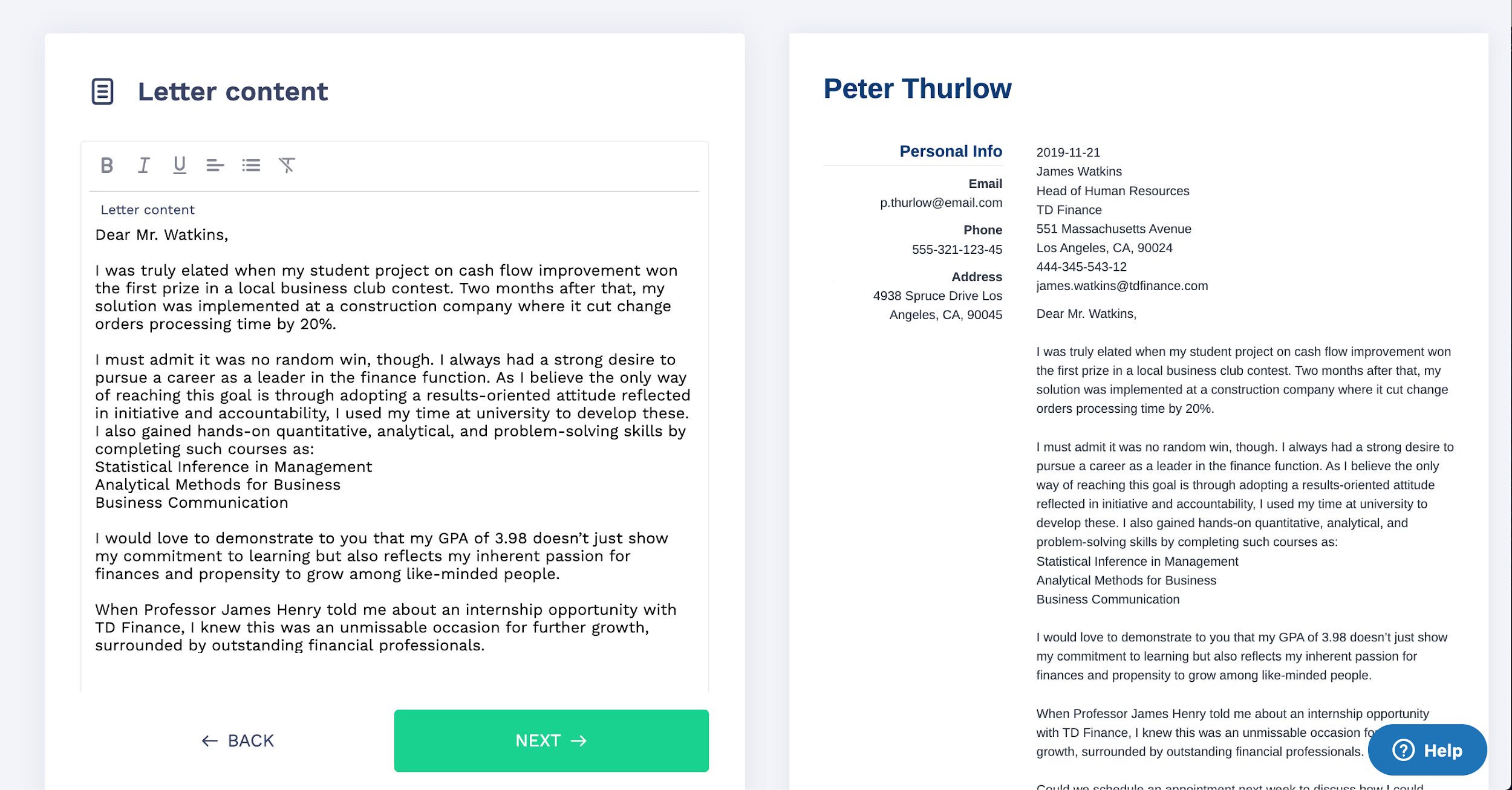
Want to try a different look? There's 21 more. A single click will give your document a total makeover. Pick a cover letter template here.
Let’s make your teacher cover letter look perfect. Its layout needs to match the template of your teacher resume. If you used one of ResumeLab’s pre-formatted templates, there’s also a matching one for your cover letter, so that’s easy. Otherwise, here are the rules you need to follow:
Formatting a cover letter is rather easy, but if you struggle, you can always rely on an online resume builder to do it for you.
If you want to learn more about cover letter layouts, check these guides:
With ResumeLab’s resume builder you’ll write your resume in a flash. Get specific content to boost your chances of getting the job. Add job descriptions, bullet points, and skills. Improve your resume in our resume builder now.
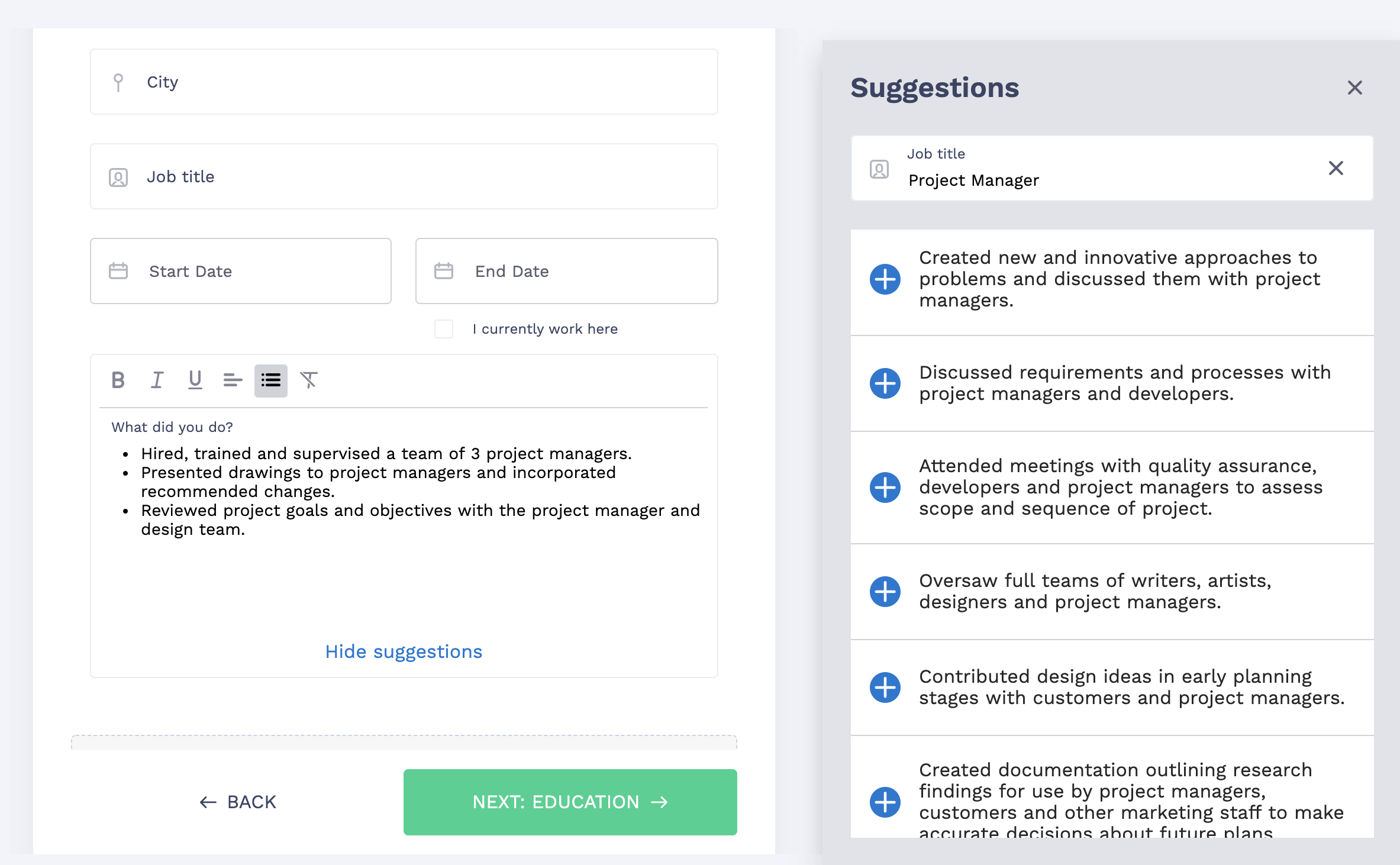
Nail it all with a splash of color, choose a clean font, highlight your skills in just a few clicks. You’re the perfect candidate and we’ll prove it. Just pick one of 21 resume templates and get started now.
Now that you feel educated on the subject of writing a teacher cover letter, don’t let anything stop you from getting the job. How about trying out our cover letter builder to make your job application ASAP? Good luck!
At ResumeLab, quality is at the crux of our values, supporting our commitment to delivering top-notch career resources. The editorial team of career experts carefully reviews every article in accordance with editorial guidelines, ensuring the high quality and reliability of our content. We actively conduct original research, shedding light on the job market's intricacies and earning recognition from numerous influential news outlets. Our dedication to delivering expert career advice attracts millions of readers to our blog each year.

Tired of constantly looking for subbing jobs? With this substitute teacher cover letter, you will be on every principal’s speed dial.

Dave Rygielski
Career Expert
![ESL Teacher Cover Letter—Samples [+ No Experience]](https://cdn-images.resumelab.com/pages/thumbnail_1_esl_teacher_rlus.jpg)
Teaching ESL is a superpower. You give students (and sometimes entire families) a leg up in life, and you do it with passion. Prove it in your ESL teacher cover letter.

Aleksandra Makal
Career Expert
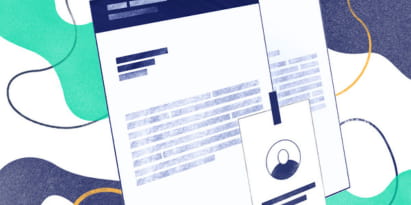
We’ve completed the research for you—all you need to do is input your data, and your cover letter for assistant professor positions will be ready to win you a job.

Dominika Kowalska, CPRW
Career Expert